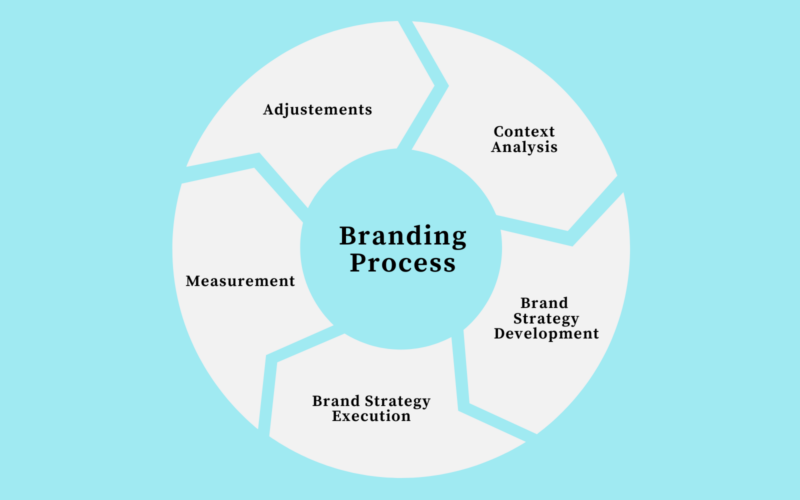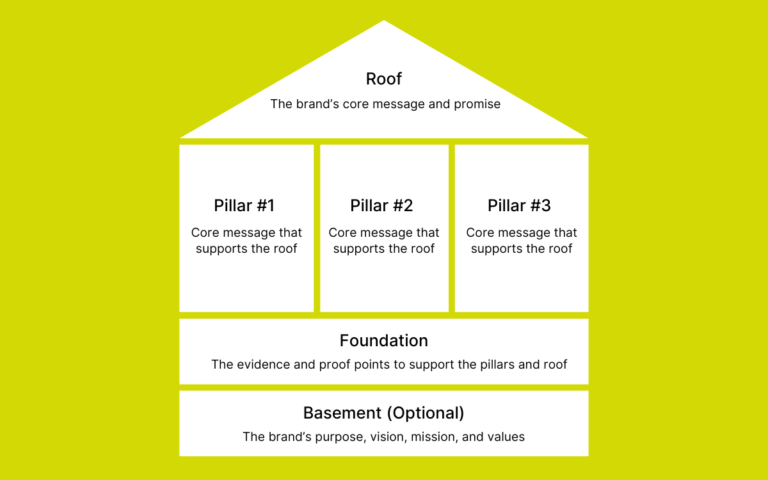Have you ever wondered how concepts like “logo,” “visual identity,” “brand identity,” “brand positioning,” “brand management,” or “rebrand” are interconnected in the realm of branding?
I find it satisfying when abstract concepts like “branding” fit into clear step-by-step processes and frameworks. It helps provide structure and make it easier to understand and actionable.
After reading this article, I hope you will leave with a clearer idea of the main steps involved in a branding process. Here, we will look at the branding process wheel, which is a complete loop that reflects the ongoing nature of branding.
The complete branding process can be divided into five main parts:
- Context analysis
- Brand strategy development
- Brand strategy execution
- Measurement
- Adjustments

Proven Systems for Business Owners, Marketers, and Agencies
→ Our mini-course helps you audit and refine an existing brand in 15 days, just 15 minutes a day.
→ The Ultimate Brand Building System is your step-by-step blueprint to building and scaling powerful brands from scratch.
Table of Contents
1. Context Analysis
The first and most crucial step of a brand strategy is analyzing the organization’s context. A strategy should always be based on concrete research and insights.
The context analysis can be divided into three main sections:
- Understanding your environment: The first step in context analysis involves analyzing the market, industry, competitors, and stakeholders, as well as opportunities and threats in society. Here, it’s essential to understand what’s happening around you and what could happen in the future to ensure your brand remains strong and relevant over time.
- Understanding your organization: The second step of the context analysis involves thoroughly understanding your organization’s capabilities, strengths, and weaknesses. This step is crucial because it will enable you to determine your brand promise more effectively. A brand promise should be grounded in the organization’s capabilities, ensuring it can always be delivered. By identifying your organization’s strengths and weaknesses, you’ll have a clearer idea of which assets to capitalize on and which weaknesses to address.
- Understanding your customers: Creating a strong brand means giving customers what they really want by focusing on their needs. This step of the analysis is essential and involves researching the needs of your current and potential customers. It also consists of doing market segmentation and choosing which consumer groups to target, knowing that a brand can appeal to more than one group.
2. Brand Strategy Development
Armed with the insights gathered during the context analysis, organizations can proceed to the development of a robust and complete brand strategy. This stage involves defining the brand’s essence, positioning, identity, and architectureBrand architecture defines the role of each brand and acts as a guideline for the interrelationship between the brands in your organization..
- Brand essence is the heart and soul of your organization, encompassing its purpose, vision, mission, and values.
- Brand positioning defines how you want your brand to be perceived compared to other players, including the positioning map, statement, and brand promise.
- Brand identity showcases what makes your brand unique and how you want it to be perceived and experienced. It encompasses cultural and historical roots, name, personality, communication style, tone of voice, the brand as a product, visual identity, and sensory identity.
- Brand architecture determines where your brand sits within your organization’s structure.
3. Brand Strategy Execution
With the brand strategy in place, the next stage involves translating strategy into action through effective execution. This stage is about:
- Aligning internal stakeholders, departments, and operations with the brand strategy to ensure organizational buy-in and consistency in delivering on the brand promise. Integrating the brand strategy into day-to-day operations and decision-making processes empowers employees to embody the brand and deliver cohesive brand experiences to customers and other individuals in contact with the brand.
- Communicating the brand internally (to employees) and externally (to stakeholders). This is when the brand comes to life and becomes internally and externally visible. It involves creating a brand communications plan with defined audiences, key messages, and communication channels.
4. Measurement
Brand measurement is the process of evaluating the outcomes and results of branding efforts. This process is fundamental because it will allow us to assess if the brand remains strong and relevant over time and if we should be adjusting the strategy or not.
Within the branding context, key Performance Indicators (KPIs) are quantifiable metrics that provide information about the brand’s performance over time and for a specific objective. Organizations can measure how successful their branding efforts are by tracking key performance indicators and comparing them against the brand’s objectives.
The four main brand performance dimensions that should be measured are:
- Brand awareness: Is your brand known and recognized?
- Brand image: How is your brand perceived by your audiences? How do they feel about the brand?
- Brand preference: Why do people choose your brand over a competitor?
- Brand loyalty: Are your customers, employees, and partners loyal to your brand?
5. Adjustments
The brand measurement process allows us to evaluate whether your brand strategy has achieved the desired outcomes. At this stage, the brand might perform well per the brand strategy or require adjustments to align the results with strategic objectives.
This stage is well connected with brand management and offers several options to consider:
- Improving the brand’s actions: The first possibility is to enhance your brand’s actions by aligning them with the brand strategy and insights from your brand measurement results. This involves strengthening commitments, improving products and services, delivering on brand promises, or cultivating stronger relationships with the public.
- Brand repositioning: This strategic choice entails changing how the brand is perceived in the market by modifying its positioning strategy to influence how it is perceived in the market compared to competitors.
- Brand rejuvenation: Sometimes, a brand needs a fresh and modern look. In such cases, a brand rejuvenation process can be beneficial. This might involve refreshing the visual identity, tone of voice, or specific elements like the website while preserving the brand’s essence and overall identity.
- Rebranding: The last option is a complete rebranding process, which is the most drastic approach. It involves modifying fundamental aspects of the brand strategy, including its purpose, essence, positioning, or identity.
Key takeaways
- Branding is much more than creating a logo or a brand identity. It is a complete strategic process that could be summarizes in 5 words: analysis, strategy, execution, measurement, and adjustements.
- It is an ongoing cycle and process. Effective branding requires continuous research, strategy, evaluation and adaptation to stay relevant and resonate with the target audiences.









